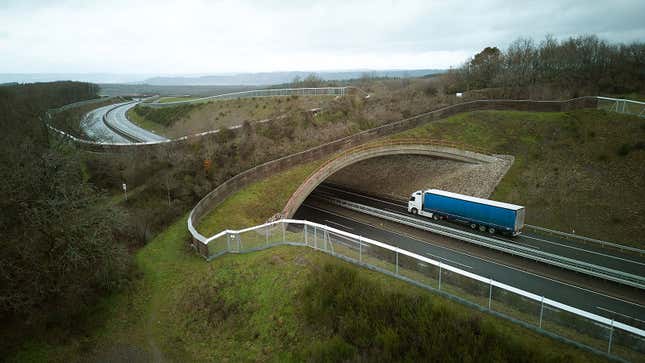American Highways Kill Animals In So Many Different Ways

Sadly, a dead animal by the side of the road is an all too familiar sight for many drivers in America. On a recent trip upstate, I lost count of the number of dead deer left by the side of the road or other animals flattened into obscurity by hundreds of car tires. But now, a new report warns that America’s roads are doing much more damage to the country’s wildlife.
Jalopinions: Turkey vs. Ham Thanksgiving Smackdown Edition
A new report from Bloomberg explained that while as many as one million animals are killed in strikes with cars across America every year, this is just the tip of the iceberg when it comes to the ecological damage caused by cars. In fact, roadkill accounts for less than a quarter of the number of animals killed every year as a result of our love affair with the automobile.
Instead, animals across America are killed by things like particulate matter released when tires rub against the road, and our ever-expanding highway network has severely hampered many creatures’ capacity to migrate and find seasonal food sources. As Bloomberg explains:
There’s the fact that road noise is driving songbirds away from important migratory stopover areas. There’s what scientists have called the “moving fence” of traffic, this impermeable wall of vehicles that prevents animals like elk and pronghorn from migrating across the American West and reaching their winter range. There’s the fact that road salts, which we dump on highways in quantities that beggars belief, are turning freshwater ecosystems brackish. Half the lakes in the Midwest are experiencing long-term salinization, which is an ominous phrase.
That quote is from environmental journalist Ben Goldfarb, who’s recent book called Crossings: How Road Ecology is Shaping the Future of Planet, breaks down the ways America’s autos are impacting the planet. While speaking with Bloomberg, Goldfarb outlines the way tire particulates have meant that an entire generation of salmon has been unable to reproduce and he warns that “species like the Florida panther that could be made extinct due to roadkill.” It’s bleak.
Tricky to say whether the moose or car won here? Photo: Arterra/Universal Images Group (Getty Images)
What’s more, the impact cars have on animals is actually going against everything we learned about evolution in school. Back then, we were taught that the fastest, strongest and most successful animals are the ones that survive to adulthood and pass on their genes.
However, Goldfarb found that it was often the stronger animals that are caught up as roadkill, or it’s a higher percentage of female animals that are killed by cars purely due to where they birth their young, as he explained:
I think about turtles, which I’ve always loved. The issue with them is that the females go wandering away from the pond looking for places to lay their eggs, and they cross roads in the process. So it’s the females that are getting killed. In many ponds, the males now vastly outnumber the females.
And this then begs the question, can America’s animals ever live in harmony with the country’s roads? According to Goldfarb: no. He argues that “wilderness is roadless,” and suggests that the “worst possible thing you can do for wildlife” in an untouched area of the country is build a road into it.

Animals have learned to use bridges like this one. Photo: Thomas Frey/picture alliance (Getty Images)
However, there are ways in which we can attempt to reduce the impact roads have on America’s wildlife. Goldfarb discusses the way animals have learned to use wildlife crossings to safely navigate highways and while he believes they are a good thing, he does warn that they “effectively address” only a handful of the issues roads and cars pose to America’s wildlife.
The whole interview is a fascinating read for anyone interested in the way wildlife and roadways interact. It can be found in full here.







